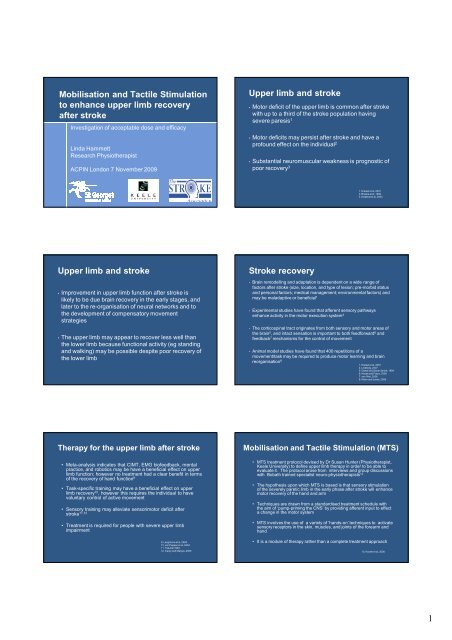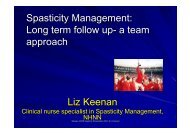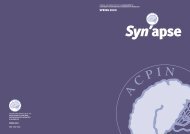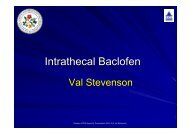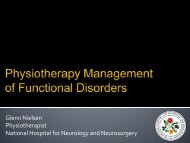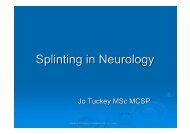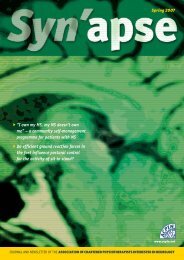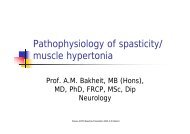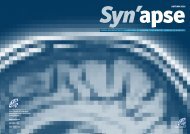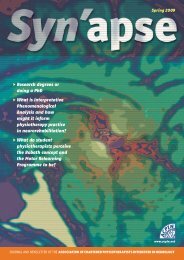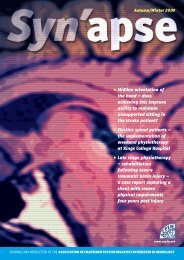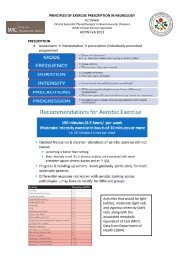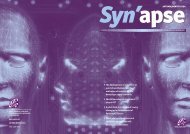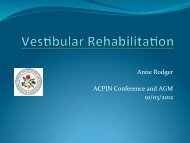Download PDF of PowerPoint presentation - acpin
Download PDF of PowerPoint presentation - acpin
Download PDF of PowerPoint presentation - acpin
Create successful ePaper yourself
Turn your PDF publications into a flip-book with our unique Google optimized e-Paper software.
Mobilisation and Tactile Stimulation<br />
to enhance upper limb recovery<br />
after stroke<br />
Investigation <strong>of</strong> acceptable dose and efficacy<br />
Linda Hammett<br />
Research Physiotherapist<br />
ACPIN London 7 November 2009<br />
Upper limb and stroke<br />
• Motor deficit <strong>of</strong> the upper limb is common after stroke<br />
with up to a third <strong>of</strong> the stroke population having<br />
severe paresis 1<br />
• Motor deficits may persist after stroke and have a<br />
pr<strong>of</strong>ound effect on the individual 2<br />
• Substantial neuromuscular weakness is prognostic <strong>of</strong><br />
poor recovery 3 1. Kreisel et al, 2007<br />
2. Broeks et al, 1999<br />
3. Kwakkel et al, 2003<br />
Upper limb and stroke<br />
• Improvement in upper limb function after stroke is<br />
likely to be due brain recovery in the early stages, and<br />
later to the re-organisation <strong>of</strong> neural networks and to<br />
the development <strong>of</strong> compensatory movement<br />
strategies<br />
• The upper limb may appear to recover less well than<br />
the lower limb because functional activity (eg standing<br />
and walking) may be possible despite poor recovery <strong>of</strong><br />
the lower limb<br />
Stroke recovery<br />
• Brain remodelling and adaptation is dependent on a wide range <strong>of</strong><br />
factors after stroke (size, location, and type <strong>of</strong> lesion; pre-morbid status<br />
and personal factors; medical management; environmental factors) and<br />
may be maladaptive or beneficial 1<br />
• Experimental studies have found that afferent sensory pathways<br />
enhance activity in the motor execution system 4<br />
• The corticospinal tract originates from both sensory and motor areas <strong>of</strong><br />
the brain 5 , and intact sensation is important to both feedforward 6 and<br />
feedback 7 mechanisms for the control <strong>of</strong> movement<br />
• Animal model studies have found that 400 repetitions <strong>of</strong> a<br />
movement/task may be required to produce motor learning and brain<br />
reorganisation 8 1. Kreisel et al, 2007<br />
4. Lindberg, 2007<br />
5. Galea and Darian Smith, 1994<br />
6. Hesse and Franz, 2009<br />
7. van Vliet, 2006<br />
8. Kleim and Jones, 2008<br />
Therapy for the upper limb after stroke<br />
• Meta-analysis indicates that CIMT, EMG bi<strong>of</strong>eedback, mental<br />
practice, and robotics may be have a beneficial effect on upper<br />
limb function; however no treatment had a clear benefit in terms<br />
<strong>of</strong> the recovery <strong>of</strong> hand function 9<br />
• Task-specific training may have a beneficial effect on upper<br />
limb recovery 10 , however this requires the individual to have<br />
voluntary control <strong>of</strong> active movement<br />
• Sensory training may alleviate sensorimotor deficit after<br />
stroke 11,12<br />
• Treatment is required for people with severe upper limb<br />
impairment<br />
9. Langhorne et al, 2009<br />
10. van Peppen et al, 2004<br />
11. Yekutiel 1993<br />
12. Carey and Matyas, 2005<br />
Mobilisation and Tactile Stimulation (MTS)<br />
• MTS treatment protocol devised by Dr Susan Hunter (Physiotherapist,<br />
Keele University) to define upper limb therapy in order to be able to<br />
evaluate it. The protocol arose from interviews and group discussions<br />
with Bobath trained specialist neuro-physiotherapists 12<br />
• The hypothesis upon which MTS is based is that sensory stimulation<br />
<strong>of</strong> the severely paretic limb in the early phase after stroke will enhance<br />
motor recovery <strong>of</strong> the hand and arm<br />
• Techniques are drawn from a standardised treatment schedule with<br />
the aim <strong>of</strong> ‘pump-priming the CNS’ by providing afferent input to effect<br />
a change in the motor system<br />
• MTS involves the use <strong>of</strong> a variety <strong>of</strong> ‘hands-on’ techniques to activate<br />
sensory receptors in the skin, muscles, and joints <strong>of</strong> the forearm and<br />
hand<br />
• It is a module <strong>of</strong> therapy rather than a complete treatment approach<br />
13. Hunter et al, 2006<br />
1
Mobilisation and Tactile Stimulation<br />
(MTS)<br />
Components <strong>of</strong> MTS<br />
PASSIVE MOVEMENTS<br />
THROUGH RANGE<br />
ACCESSORY MOVEMENTS<br />
MASSAGE<br />
PLACING THE HAND ON<br />
COMPRESSION<br />
PATTERNS OF CO-ORDINATED<br />
MOVEMENT UNDERLYING<br />
FUNCTIONAL ACTIVITY<br />
SOFT TISSUE STRETCH<br />
ISOLATED/SELECTIVE JOINT<br />
MOVEMENT<br />
SPECIFIC SENSORY INPUT<br />
Guidance to therapists<br />
• Treatment is <strong>of</strong> the forearm and<br />
hand only<br />
• Adapt treatment (e.g.<br />
combination <strong>of</strong> techniques) to suit<br />
the <strong>presentation</strong> <strong>of</strong> the individual<br />
Pro<strong>of</strong>-<strong>of</strong>-concept study<br />
Initial stage in evaluating a treatment under the<br />
Medical Research Council’s guidelines on the<br />
development <strong>of</strong> complex interventions<br />
Design<br />
• A series <strong>of</strong> six replicated single case studies<br />
(ABA design)<br />
Participants<br />
• People within three months <strong>of</strong> stroke<br />
Results<br />
• All participants showed improvements in<br />
outcome measures in response to MTS<br />
Pro<strong>of</strong>-<strong>of</strong>-concept study<br />
AR AT score<br />
Subject 2, Action Research Arm Test (ARAT)<br />
Baseline<br />
57<br />
Intervention<br />
No intervention<br />
38<br />
19<br />
0<br />
1 5 9 13 17 21 25 29 33 37 41 45 49 53 57 61 65 69 73 77 81 85<br />
Days<br />
Dose (Intensity)<br />
• Retrospective reviews <strong>of</strong> physiotherapy in stroke<br />
suggest that increased intensity is beneficial 15,16<br />
• A confounding factor <strong>of</strong> these studies is that different<br />
types <strong>of</strong> therapy are included in the analyses. The<br />
findings are equivocal when analysis controls for the<br />
type <strong>of</strong> therapy 17<br />
• Limited number <strong>of</strong> studies in which dose is evaluated<br />
• Need for prospective studies <strong>of</strong> intensity 18<br />
15. Kwakkel et al, 1997<br />
16. Langhorne et al, 1996<br />
17. Cook, 2008<br />
18. Dobkin, 2009<br />
Dose Finding<br />
• Essential part <strong>of</strong> the evaluation <strong>of</strong> therapy, however, rarely<br />
explicitly addressed 14<br />
• Ad hoc identification <strong>of</strong> dose<br />
• What is rehabilitation dose?<br />
• Length <strong>of</strong> each treatment session<br />
• Number <strong>of</strong> treatment sessions<br />
• Duration <strong>of</strong> treatment intervention (days/weeks)<br />
• Number <strong>of</strong> repetitions<br />
• Resistance (eg weight used in strength training)<br />
• Rehabilitation dose is <strong>of</strong>ten thought <strong>of</strong> as intensity (time spent<br />
in therapy)<br />
• The present study is thought to be the first prospective Phase I<br />
dose-finding trial <strong>of</strong> a stroke rehabilitation therapy 14. Pomeroy and Tallis, 2003<br />
2
Aims <strong>of</strong> this dose-finding study<br />
Participants<br />
• To determine which dose <strong>of</strong> MTS therapy<br />
has the most beneficial effect on voluntary<br />
muscle contraction and functional ability<br />
• To determine which dose <strong>of</strong> MTS produces<br />
the least adverse events<br />
Characteristics<br />
• Anterior circulation stroke 8-84 days prior to<br />
recruitment<br />
• Paralysis or severe paresis in upper limb<br />
• No clinically important upper limb pain<br />
• Able to follow single stage commands<br />
Sample size<br />
• 76 participants at two clinical centres (in<br />
London & North Staffordshire)<br />
Power calculation<br />
Method<br />
• A power calculation was completed based on<br />
the results <strong>of</strong> the pro<strong>of</strong>-<strong>of</strong>-concept study<br />
• A sample size <strong>of</strong> 20 participants per group<br />
was expected to give 80% power at 0.05%<br />
significance to detect clinical improvement in<br />
at least 50.9% <strong>of</strong> people in the combined<br />
experimental group<br />
• This estimate was based on the assumption<br />
that 20% <strong>of</strong> the control group would improve<br />
Group A<br />
Current therapy<br />
Days 2-15<br />
Group B<br />
Current therapy &<br />
30 minutes MTS<br />
Days 2-15<br />
Screening,<br />
informed consent and<br />
recruitment<br />
Baseline measures<br />
– blind assessor<br />
Day 1<br />
Randomisation<br />
(central <strong>of</strong>fice)<br />
Outcome measures<br />
Day 16<br />
Group C<br />
Current therapy &<br />
60 minutes MTS<br />
Days 2-15<br />
Group D<br />
Current therapy &<br />
120 minutes MTS<br />
Days 2-15<br />
Experimental intervention: MTS<br />
Conventional upper limb therapy<br />
• A research therapist in each centre provided the<br />
experimental intervention<br />
• Each treatment was recorded on a standard pr<strong>of</strong>orma<br />
• The pattern <strong>of</strong> treatment (eg length <strong>of</strong> treatment<br />
sessions) was agreed with the participant<br />
• Provision <strong>of</strong> the experimental intervention had to fit in<br />
around standard therapy, meals, rest periods,<br />
investigations, visitors etc<br />
• The physiotherapists on the stroke units were<br />
asked to complete a pr<strong>of</strong>orma recording their<br />
treatment <strong>of</strong> the upper limb<br />
• Upper limb interventions provided by other<br />
members <strong>of</strong> the MDT were not recorded<br />
3
Primary outcome measure<br />
Motricity Index<br />
Secondary outcome measure<br />
Action Research Arm Test (ARAT)<br />
Gross grip<br />
Pronation<br />
Pinch grip Elbow flexion Shoulder abduction<br />
Pinch grip<br />
Gross movements<br />
Outcome Measurements<br />
Adverse events<br />
• Assessors trained together to ensure consistency <strong>of</strong><br />
use <strong>of</strong> the outcome measures<br />
• The Motricity Index is a clinical measure <strong>of</strong> ability to<br />
voluntarily contract paretic muscle 19 , and has been<br />
found to be sensitive to change in people with stroke<br />
and low level <strong>of</strong> motor function 20<br />
• The ARAT is a measure <strong>of</strong> upper limb function 21<br />
• Participants were monitored throughout the<br />
study for upper limb pain and deterioration <strong>of</strong><br />
motor function<br />
• If an adverse event had been recorded on<br />
three consecutive days then the experimental<br />
intervention would have been discontinued<br />
19. Demeurisse et al, 1980<br />
20. Jacob-Lloyd et al, 2005<br />
21. Lyle, 1981<br />
Recruitment<br />
Exclusions<br />
Did not meet inclusion<br />
criteria (n = 675)<br />
Out <strong>of</strong> area or discharged<br />
(n = 88)<br />
Interpreter required (n = 7)<br />
Already in another therapy<br />
trial (n = 41)<br />
Declined consent (n = 15)<br />
(n = 75)<br />
Outcomes<br />
Randomised<br />
(n = 76)<br />
Excluded (n = 836)<br />
Assessed for eligibility<br />
(n = 912)<br />
Withdrawals<br />
(All in 60 min MTS<br />
group)<br />
2 people did not<br />
complete intervention<br />
due to transfer (but<br />
completed outcomes)<br />
1 person died<br />
Baseline characteristics<br />
No MTS<br />
30 min MTS 60 min MTS 120 min MTS<br />
n=19<br />
n=18<br />
n=19<br />
n=20<br />
Centre<br />
London 7 8 9 10<br />
Keele 12 10 10 10<br />
Gender<br />
Male 10 (53%) 11 (61%) 8 (42%) 9 (45%)<br />
Female 9 (47%) 7 (39%) 11 (58%) 11 (55%)<br />
Age in years : mean (standard deviation)<br />
74.3 (13.2) 76.2 (17.9) 72.5 (11.8) 73.5 (15.8)<br />
Days since stroke: mean (standard deviation)<br />
31.9 (14.4) 39.0 (26.9) 30.0 (19.9) 31.5 (20.1)<br />
Motricity Index: median (interquartile range)<br />
10.0 (1-40) 5.5 (1-40) 12.0 (1-40) 12.5 (1-44)<br />
4
Baseline characteristics<br />
No MTS<br />
30 min MTS 60 min MTS 120 min MTS<br />
n=19<br />
n=18<br />
n=19<br />
n=20<br />
Stroke classification<br />
ICH 2 1 2 2<br />
LACI 3 2 4 3<br />
PACI 5 7 6 8<br />
TACI 9 7 7 7<br />
Unknown 0 1 0 0<br />
Neglect<br />
Not present 14 (74%) 13 (72%) 12 (63%) 14 (70%)<br />
Present 5 (26%) 5 (28%) 7 (37%) 6 (30%)<br />
Hemiplegic side<br />
Left 11 (58%) 14 (78%) 15 (79%) 13 (65%)<br />
Right 8 (42%) 4 (22%) 4 (21%) 7 (35%)<br />
Dominant hand affected<br />
Yes 7 (37%) 5 (28%) 4 (21%) 8 (40%)<br />
No 12 (63%) 13 (72%) 15 (79%) 12 (60%)<br />
Results – Motricity Index<br />
The shaded box<br />
represents the IQR,<br />
with the upper area<br />
representing the upper<br />
quartile, and the area<br />
below the line<br />
representing the lower<br />
quartile.<br />
The horizontal line in<br />
the box represents the<br />
median value.<br />
The whiskers stretch<br />
out to the minimum and<br />
maximum values.<br />
Results - Motricity index<br />
Results - ARAT<br />
• Ordinal scale therefore non-parametric statistics completed<br />
(Freidman’s Test and Kruskall-Wallis Test)<br />
• The change in the median score <strong>of</strong> each group (including the<br />
control) was statistically significant on the Freidman’s Test<br />
• The greatest change was seen in the 60 minute MTS group<br />
• Little evidence <strong>of</strong> a statistical trend, as assessed by the Kruskall-<br />
Wallis Test, across the groups (large inter-quartile ranges)<br />
• All <strong>of</strong> the intervention groups contained more participants with a<br />
change <strong>of</strong> three points or more on the Motricity Index than the<br />
control group<br />
• The change in the median score <strong>of</strong> each <strong>of</strong> the<br />
intervention groups was statistically significant on the<br />
Freidman’s Test (the change in the control group did<br />
not reach statistical significance)<br />
• No statistically significant trend on the Kruskall-Wallis<br />
Test<br />
• The baseline values were more variable across the<br />
groups than the Motricity Index scores<br />
Results - Adverse events<br />
Results - Dose <strong>of</strong> MTS delivered<br />
Percentage <strong>of</strong> MTS delivered by group<br />
• None <strong>of</strong> the participants experienced an<br />
adverse event<br />
• One person experienced pain, however the<br />
clinical team identified that this was due to a<br />
subluxed shoulder and adjudged that it was<br />
unrelated to the intervention<br />
100<br />
90<br />
80<br />
70<br />
60<br />
50<br />
40<br />
30<br />
20<br />
10<br />
0<br />
30 minutes MTS 60 minutes MTS 120 minutes MTS<br />
Mean number <strong>of</strong> treatment sessions<br />
12.3 11.6 22.2<br />
Mean length <strong>of</strong> each session (minutes)<br />
25.5 45.8 44.3<br />
5
Discussion<br />
• Significant improvement, as measured by the Motricity<br />
Index was seen in all groups. As the trial was in the<br />
sub-acute phase after stroke this may have been due<br />
to natural recovery.<br />
• No statistically significant improvement in the control<br />
group on the ARAT, although all <strong>of</strong> the MTS groups<br />
did show a statistically significant improvement. This<br />
may suggest that the improvement on the Motricity<br />
Index was due to a learning effect as this measure<br />
was repeated on a daily basis to assess for adverse<br />
events.<br />
Discussion<br />
• No statistically significant trends in the results<br />
• Insufficient power to detect changes as the control<br />
group improved more than expected<br />
• Unable to analyse the conventional therapy as too few<br />
treatment records completed<br />
• Unable to deliver 120 minute dose due to participant<br />
preference and logistical problems<br />
Study Conclusions<br />
• Improvement in motor performance can be<br />
seen in the severely impaired stroke<br />
population in the sub-acute phase after stroke<br />
• No clear dose-related response was<br />
demonstrated, although there was a trend for<br />
better outcomes with 60 and 120 minutes <strong>of</strong><br />
MTS<br />
Limitations <strong>of</strong> the study<br />
• population/recruitment<br />
• power (in view <strong>of</strong> changes in the control)<br />
• blinding<br />
• outcome measures<br />
• potential differences across the two sites<br />
• absence <strong>of</strong> data on conventional therapy<br />
• adverse events monitoring<br />
Further work<br />
• MTS<br />
• Further description/guidance<br />
• Evaluation <strong>of</strong> efficacy<br />
• Alternative provision (Rehab assistants/relatives)<br />
• Target population (severe paresis)<br />
• Outcome measures<br />
• Sensitivity<br />
• Sensation<br />
• Clinically important changes<br />
Summary<br />
• Evidence based practice requires scientifically rigorous research<br />
– the definition <strong>of</strong> interventions and dose is crucial<br />
• It is difficult to evaluate ‘complex interventions’, such as<br />
physiotherapy. Appropriate outcome measures that are valid,<br />
reliable and sensitive are required.<br />
• MTS – 60-120 minutes/day may be beneficial in the early stages<br />
after stroke for people with severe impairment (more research is<br />
needed…)<br />
• The impact <strong>of</strong> fatigue in the stroke population should be<br />
considered when planning and delivering therapy<br />
• Dose finding<br />
6
Should I change my practice in response to this<br />
study?<br />
• Possibly not!<br />
• But… there is little therapy available for people with severely<br />
impaired upper limbs after stroke and there is some experimental<br />
evidence to suggest that sensory interventions are beneficial.<br />
• There is a danger that an assumption that those with severe<br />
impairments will not improve will become a self-fulfilling<br />
prophecy. Therapy may be limited, or people will be taught<br />
compensatory strategies from a very early stage, which may lead<br />
to learned non-use, s<strong>of</strong>t tissue shortening, or disuse atrophy.<br />
References<br />
1. Kreisel SH; Hennericci MG; Bazner H Pathophysiology <strong>of</strong> Stroke Rehabilitation: The<br />
Natural Course <strong>of</strong> Clinical Recovery, Use-Dependent Plasticity and Rehabilitative<br />
Outcome. Cerebrovascular Diseases, 2007, 23, 243-255<br />
2. Broeks J G, Langhorst G J, Rumpling K, Prevo A J H. The long-term outcomes <strong>of</strong> arm<br />
function after stroke: results <strong>of</strong> a follow-up study. Disability and Rehabilitation<br />
(1999);21(8):357-364.<br />
3. Kwakkel G; Kollen B; van der Grond J; Prevo AJH Probability <strong>of</strong> Regaining Dexterity in<br />
the Flaccid Upper Limb. Stroke, 2003, 34, 2181<br />
4. Lindberg P G, Schmitz C, Engardt M, Forssberg H, Borg J. Use-Dependent Up- and<br />
Down-Regulation <strong>of</strong> Sensorimotor Brain Circuits in Stroke Patients. Neurorehabilitation<br />
and Neural Repair 2007;21(4):315-326.<br />
5. Galea M P and Darian-Smith I Postnatal Maturation <strong>of</strong> the Direct Corticospinal<br />
Projections in the Macaque Monkey. Cerebral Cortex, 1995, 5:518-40<br />
6. Hesse C, Franz VH. Corrective processes in grasping after perturbations <strong>of</strong> object size.<br />
J.Mot.Behav. 2009 05;41(3):253-273.<br />
7. van Vliet P M and Wulf G. Extrinsic feedback for motor learning after stroke: What is the<br />
evidence? Disability and Rehabilitation 2006;28(13-14):831-840.<br />
8. Kleim JA and Jones TA Principles <strong>of</strong> experience-dependent neural plasticity: implications<br />
for rehabilitation after brain damage. Journal <strong>of</strong> Speech, Language and Hearing<br />
Research 2008 51:S225-S239<br />
9. Langhorne P, Coupar F, Pollock A Motor recovery after stroke: a systematic review.<br />
Lancet Neurology 2009 8 (8) 741-54<br />
10. van Peppen RPS, Kwakkel G, Wood-Dauphinee S, Hendriks HJM, ven der Wees PLJ,<br />
Dekker J The impact <strong>of</strong> physical therapy on functional outcomes after stroke:what’s the<br />
evidence? Clinical Rehabilitation 2004 833-862<br />
11. Yekutiel M, Guttmann E. A controlled trial <strong>of</strong> the retraining <strong>of</strong> the sensory function <strong>of</strong> the<br />
hand in stroke patients. Journal <strong>of</strong> Neurology, Neurosurgery and Psychiatry 1993;56:241-<br />
244.<br />
References<br />
12. Carey L M and Matyas T A, Training <strong>of</strong> somatosensory discrimination after stroke:<br />
Facilitation <strong>of</strong> stimulus generation. American Journal <strong>of</strong> Physical & Medical Rehabilitation<br />
2005;84:428-442.<br />
13. Hunter S M, Crome P, Sim J, Donaldson C, Pomeroy VM Development <strong>of</strong> treatment<br />
schedules for research: a structured review to identify methodologies used and a worked<br />
example <strong>of</strong> ‘mobilisation and tactile stimulation’ for stroke patients. Physiotherapy 92<br />
(2006) 195-207<br />
14. Pomeroy VM, Tallis RC. Avoiding the menace <strong>of</strong> evidenced-tinged neuro-rehabilitation:<br />
Viewpoint. Physiotherapy 2003 Oct;89(10):595-601.<br />
15. Kwakkel G, Wagenaar R C, Koelman T W, Lankhorst G J, Koetsier J C. Effects <strong>of</strong><br />
intensity <strong>of</strong> rehabilitation after stroke. A research synthesis. Stroke 1997;28:1550-1556<br />
16. Langhorne P, Wagenaar R, Partridge C Physiotherapy after stroke: more is better?<br />
Physiotherapy Research International 1(2):75-88, 1996.<br />
17. Cook E, PhD thesis St George’s University <strong>of</strong> London, 2008<br />
18. Dobkin BH Progressive staging <strong>of</strong> pilot studies to improve Phase III trials for motor<br />
interventions Neurorehabilitation and Neural Repair 2009 23:197-206<br />
19. Demeurisse G, Demol O, Robaye E Motor evaluation in vascular hemiplegia European<br />
Neurology, 1980 19 382-9<br />
20. Jacob-Lloyd H A, Dunn O M, Brain N D, Lamb S E, Effective measurement <strong>of</strong> the<br />
functional progress <strong>of</strong> stroke clients. British Journal <strong>of</strong> Occupational Therapy 2005 68(6)<br />
253-9<br />
21. Lyle R C, A performance test for assessment <strong>of</strong> upper limb function in physical<br />
rehabilitation treatment and research. International Journal <strong>of</strong> Rehabilitation Research<br />
1981, 4, 483-92<br />
Contact details<br />
Linda Hammett<br />
lhammett@sgul.ac.uk<br />
lindahammett@hotmail.com<br />
7


